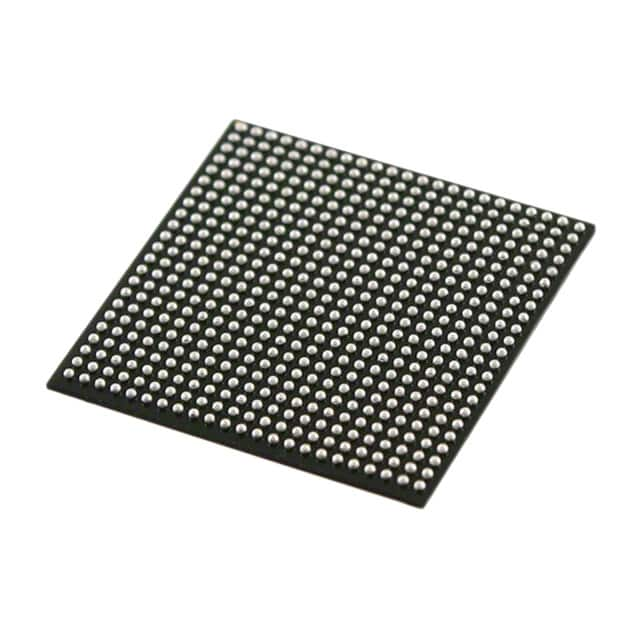Xem thông số kỹ thuật để biết chi tiết sản phẩm.

5CEBA4U19C7N
Product Overview
Category
5CEBA4U19C7N belongs to the category of Field Programmable Gate Arrays (FPGAs).
Use
This product is primarily used in digital logic circuits and electronic systems for various applications.
Characteristics
- High-performance programmable logic device
- Offers flexibility and reconfigurability
- Provides high-speed data processing capabilities
- Supports complex algorithms and computations
- Enables rapid prototyping and system development
Package
The 5CEBA4U19C7N FPGA is available in a compact package, suitable for integration into electronic systems.
Essence
The essence of 5CEBA4U19C7N lies in its ability to provide a customizable and versatile solution for digital circuit design and implementation.
Packaging/Quantity
The product is typically packaged individually and is available in various quantities depending on the requirements of the user.
Specifications
- Logic Elements: 19,200
- Embedded Memory: 608 Kbits
- Maximum User I/Os: 346
- Maximum Distributed RAM: 1,152 Kbits
- Maximum PLLs: 4
- Maximum Global Clock Networks: 16
- Operating Voltage: 1.2V
- Speed Grade: C7
Detailed Pin Configuration
The pin configuration of 5CEBA4U19C7N is as follows:
- Pin 1: VCCIO
- Pin 2: GND
- Pin 3: IO_0
- Pin 4: IO_1
- ...
- Pin 346: IO_345
Functional Features
- High-speed data processing capability
- Configurable logic elements for custom circuit design
- Embedded memory for data storage
- Flexible I/O options for interfacing with external devices
- Support for various communication protocols
- On-chip PLLs for clock generation and synchronization
Advantages and Disadvantages
Advantages
- Flexibility and reconfigurability
- High-performance processing capabilities
- Rapid prototyping and system development
- Support for complex algorithms and computations
Disadvantages
- Higher power consumption compared to fixed-function ASICs
- Limited resources and capacity compared to larger FPGAs
- Steeper learning curve for beginners
Working Principles
The 5CEBA4U19C7N FPGA operates based on the principles of configurable logic elements, embedded memory, and programmable interconnects. The user can program the device using Hardware Description Languages (HDL) such as VHDL or Verilog to define the desired digital circuit functionality. The programmed configuration is then loaded onto the FPGA, allowing it to perform the specified operations.
Detailed Application Field Plans
The 5CEBA4U19C7N FPGA finds applications in various fields, including:
- Telecommunications: Used in base stations, network routers, and switches for high-speed data processing and protocol handling.
- Industrial Automation: Employed in control systems, robotics, and machine vision applications for real-time data processing and control.
- Aerospace and Defense: Utilized in radar systems, avionics, and military-grade communication equipment for signal processing and encryption.
- Medical Devices: Integrated into medical imaging systems, patient monitoring devices, and diagnostic equipment for data acquisition and processing.
- Automotive: Used in advanced driver-assistance systems (ADAS), infotainment systems, and engine control units (ECUs) for enhanced performance and functionality.
Detailed and Complete Alternative Models
- 5CEBA2U19C7N: A lower-capacity version of the same FPGA series, suitable for smaller-scale applications.
- 5CEBA6U19C7N: A higher-capacity version of the same FPGA series, offering increased resources for more complex designs.
- 5CEBA4U15C7N: A similar FPGA with a lower speed grade, suitable for applications with less stringent timing requirements.
(Note: The above alternative models are provided for illustrative purposes and may not represent the complete range of available alternatives.)
In conclusion, the 5CEBA4U19C7N FPGA is a high-performance programmable logic device that offers flexibility, reconfigurability, and high-speed data processing capabilities. It finds applications in various fields such as telecommunications, industrial automation, aerospace, defense, medical devices, and automotive. While it has advantages in terms of customization and performance, it also has limitations in terms of power consumption and resource capacity.
Liệt kê 10 câu hỏi và câu trả lời thường gặp liên quan đến ứng dụng 5CEBA4U19C7N trong giải pháp kỹ thuật
Sure! Here are 10 common questions and answers related to the application of 5CEBA4U19C7N in technical solutions:
Q: What is 5CEBA4U19C7N? A: 5CEBA4U19C7N is a field-programmable gate array (FPGA) chip manufactured by Intel.
Q: What are the key features of 5CEBA4U19C7N? A: Some key features include high-performance logic, embedded memory blocks, digital signal processing (DSP) capabilities, and low power consumption.
Q: How can 5CEBA4U19C7N be used in technical solutions? A: It can be used for various applications such as digital signal processing, image and video processing, communication systems, industrial automation, and more.
Q: What programming languages can be used with 5CEBA4U19C7N? A: 5CEBA4U19C7N can be programmed using hardware description languages (HDLs) like VHDL or Verilog.
Q: Can 5CEBA4U19C7N be reprogrammed after deployment? A: Yes, 5CEBA4U19C7N is a reprogrammable FPGA, allowing for flexibility and updates to the design even after deployment.
Q: What are the advantages of using 5CEBA4U19C7N in technical solutions? A: Some advantages include high performance, customization, parallel processing capabilities, and the ability to implement complex algorithms.
Q: Are there any limitations to consider when using 5CEBA4U19C7N? A: Yes, some limitations include limited resources (logic cells, memory blocks), longer development time compared to using microcontrollers, and higher cost.
Q: Can 5CEBA4U19C7N interface with other components or devices? A: Yes, 5CEBA4U19C7N can interface with various components and devices through different protocols like SPI, I2C, UART, Ethernet, etc.
Q: Is there any specific software required for programming 5CEBA4U19C7N? A: Yes, Intel provides Quartus Prime software, which is commonly used for designing, simulating, and programming FPGAs including 5CEBA4U19C7N.
Q: Are there any development boards available for prototyping with 5CEBA4U19C7N? A: Yes, Intel offers development boards like the DE10-Lite board that can be used for prototyping and testing designs with 5CEBA4U19C7N.
Please note that the specific details and answers may vary depending on the context and requirements of the technical solution.

